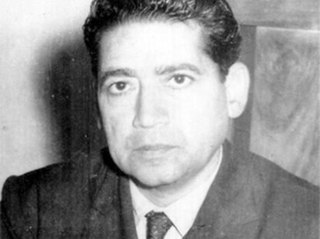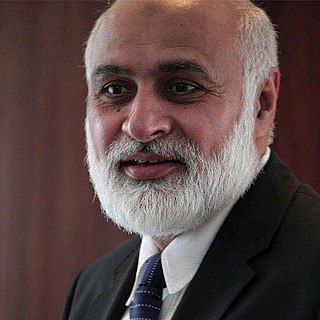
Modern Standard Hindi, commonly referred to as Hindi, is an Indo-Aryan language spoken chiefly in North India, and serves as the lingua franca of the Hindi Belt region encompassing parts of northern, central, eastern, and western India. Hindi has been described as a standardised and Sanskritised register of the Hindustani language, which itself is based primarily on the Khariboli dialect of Delhi and neighbouring areas of North India. Hindi, written in the Devanagari script, is one of the two official languages of the Government of India, along with English. It is an official language in nine states and three union territories and an additional official language in three other states. Hindi is also one of the 22 scheduled languages of the Republic of India.

Punjab, known historically as Panchanada and Pentapotamia, is a province of Pakistan. Located in central-eastern region of the country, Punjab is the second-largest province of Pakistan by land area and the largest by population. Lahore is the capital and the largest city of the province. Other major cities include Faisalabad, Rawalpindi, Gujranwala and Multan.

Punjabi, sometimes spelled Panjabi, is an Indo-Aryan language native to the Punjab region of Pakistan and India. It is one of the most widely spoken native languages in the world with approximately 113 million native speakers.

Urdu is an Indo-Aryan language spoken chiefly in South Asia. It is the national language and lingua franca of Pakistan, where it is also an official language alongside English. In India, Urdu is an Eighth Schedule language whose status and cultural heritage is recognised by the Constitution of India; and it also has an official status in several Indian states. In Nepal, Urdu is a registered regional dialect and in South Africa it is a protected language in the constitution. It is also spoken as a minority language in Afghanistan and Bangladesh, with no official status.

Lollywood is Pakistan's film industry, which has served as the base for both Urdu- and Punjabi-language film production.

Sahiwal, formerly known as Montgomery, is a city in Punjab, Pakistan. It is the 21st largest city of Pakistan by population and the administrative capital of both Sahiwal District and Sahiwal Division. Sahiwal is approximately 180 km from the major city Lahore and 100 km from Faisalabad and lies between Lahore and Multan. Sahiwal is approximately 152 meters above the sea level.

Sahiwal District, formerly known as Montgomery district, is a district in the Punjab province of Pakistan.

Pakpattan District, is a district of Punjab province in Pakistan, Pakpattan city is the district capital.

The Hindi–Urdu controversy arose in 19th century colonial India out of the debate over whether Modern Standard Hindi or Standard Urdu should be chosen as a national language.

Haryanvi is an Indo-Aryan language spoken primarily in the Indian state of Haryana and the territory of Delhi. To a lesser extent, it is spoken in the Pakistani districts of Pakpattan, Sahiwal, Okara, Bahawalpur and Multan within Punjab, Pakistan and numerous towns in Sindh as well. Haryanvi is considered to be part of the dialect group of Western Hindi, which also includes Khariboli and Braj. The Haryanvi language is written either in the Devanagari script in India, or with the Nastaliq variant of the Arabic script in Pakistan.
Munir Ahmed Niazi, was a Pakistani poet of the Punjabi and Urdu languages. He also wrote for newspapers, magazines and radio. In 1960, he established a publication institute, Al-Misal. He was later associated with Pakistan Television, Lahore and lived in Lahore till his death.
Mehdi HasanSI was a Pakistani left-wing journalist, media historian, and academician. He was one of Pakistan's most prominent communication experts, with a specialization in political analysis.
Attash Durrani was a Pakistani linguist, researcher, critic, author, educationist, and gemologist. He wrote more than 275 books and approximately 500 papers in Urdu and English. His main disciplines of study were language, education, computer science, and information technology. He was the recipient of the Tamgha-i-Imtiaz and Sitara-e-Imtiaz for his work of Urdu language and literature.
The Punjabi Language Movement (PLM) is a linguistic movement in Punjab, Pakistan aimed at reviving the Punjabi language, art, culture and literature in Pakistan. The Punjabi people constitute the largest ethnic group in Pakistan though Urdu is the national language and unlike Indian Punjab, Punjabi itself does not have an official status. The PLM's ideologies are based on Punjabi nationalism.

Badar uz Zaman was a Pakistani classical singer. He contributed to Pakistani Classical Music by promoting and re-interpreting compositions of the sub-continent's Muslim composers. Zaman performed with his brother, Ustad Qamar-uz-Zaman, carrying forward the Pakistan's own "Kasur Gharana" traditions of the art of Khayal music. Classical singers typically represent Indian Gharanas of Music.
Punjabi nationalism is an ideology which emphasizes that the Punjabis are one nation and promotes the cultural unity of Punjabis around the world. The demands of the Punjabi nationalist movement are linguistic, cultural, economic and political rights.
Sarmad Sehbai is a Pakistani poet, playwright, film and theatre director, worked in Urdu, Punjabi and English languages.

Feroz Nizami, was a Pakistani film score composer, music director and classical singer.

Niaz Ahmad Akhtar is a Pakistani academic who is currently serving as the vice-chancellor of Quaid-i-Azam University, in office since 14 March 2023. He is also the vice-chairman of the Pakistan Engineering Council from Punjab.
Sindhi is a language broadly spoken by the people of the historical Sindh region in the Indo subcontinent. Modern Sindhi is written in an extended Perso-Arabic script in Sindh province of Pakistan and (formally) in extended-Devanagari by Sindhis in partitioned India. Historically, Sindhi was written in various forms of Landa scripts and various other Indic scripts.













